Historic LDS Kirtland
Introduction
Text-to-speech Audio
Images
Exterior shot of the sawmill
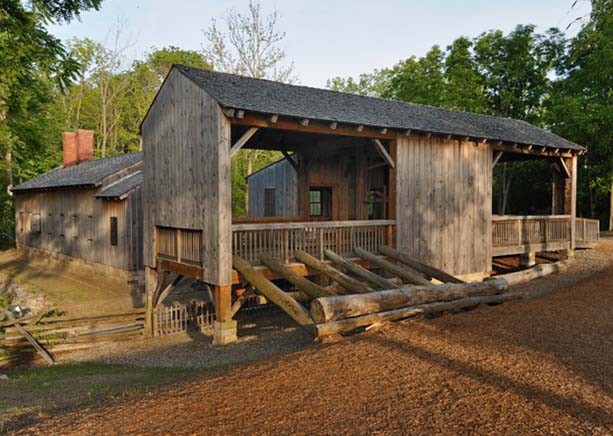
Interior view of the Ashery
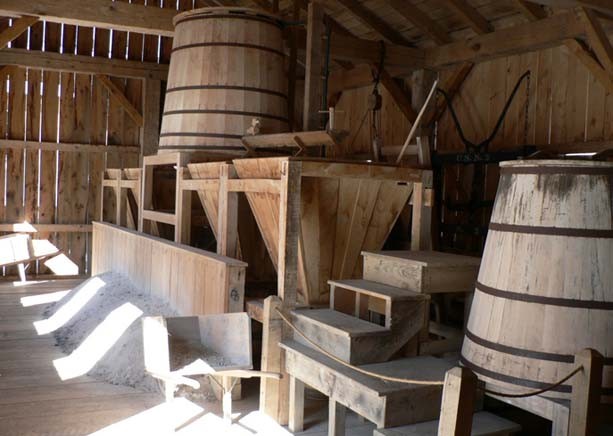
John Johnson Inn and Resource Center
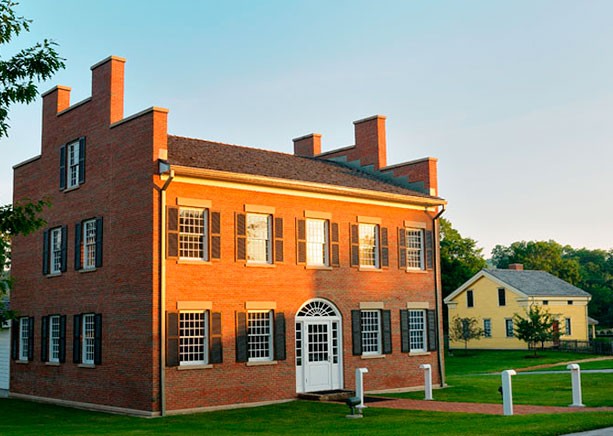
interior of schoolhouse
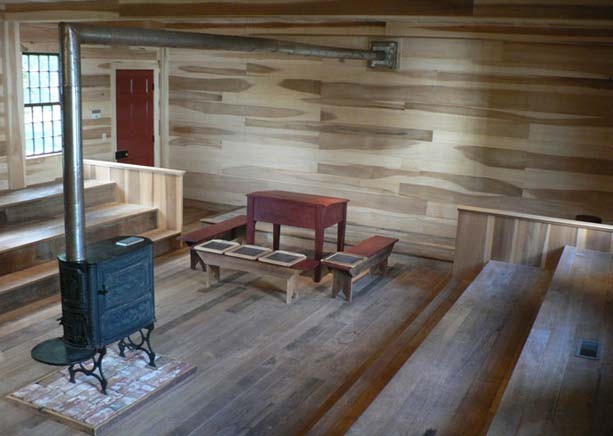
Kirtland Temple

Kirtland Stone Quarry. One can see where sandstone has been cut out.
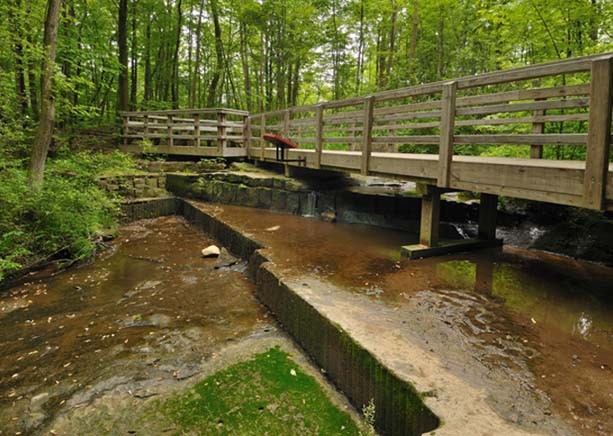
Lobby of LDS Visitors Center in Kirtland.
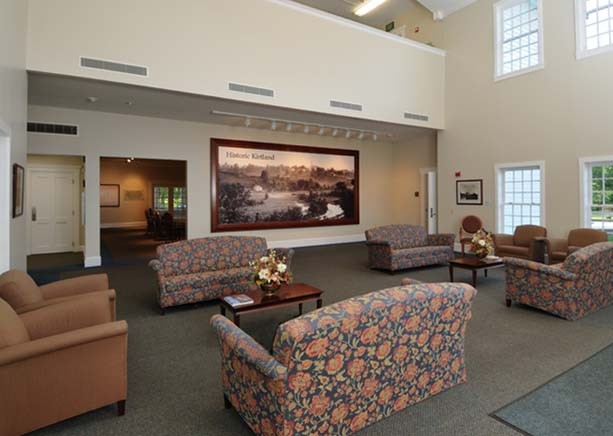
Newel K. Whitney Store
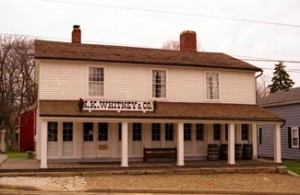
Newel K. Whitney Home
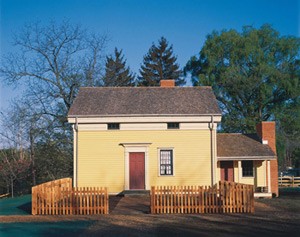
undated rendering of Newel K. Whitney
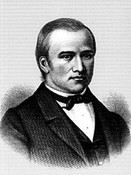
Scene depicting Joseph Smith introducing himself to Newel K. Whitney
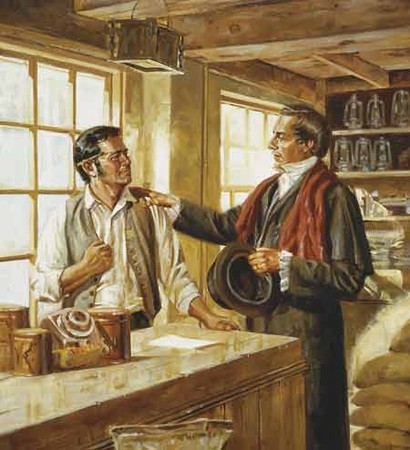
Backstory and Context
Text-to-speech Audio
From 1831 to 1838, Kirtland was the headquarters for the Latter Day Saint movement. Joseph Smith moved the church to Kirtland in 1831, shortly after its formal organization in April 1830 in Palmyra, New York. Latter Day Saints built their first temple there, a historic landmark that is now owned and operated by the Community of Christ, a group descended from the church founded by Smith. The temple was built with a degree of opulence, considering the underdeveloped nature of the area and the poverty of most early church members. Many attending the Kirtland Temple dedication in 1836 claimed to see multiple heavenly visions and appearances of heavenly beings, including the deity. For this and other reasons, Kirtland remains a place of importance to those of all Latter Day Saint denominations. Many sections from the Doctrine and Covenants, considered modern revelations and canonical by most denominations within the Latter Day Saint movement, originated in Kirtland during the 1830s.
Ownership of the Kirtland Temple was in a confused state and disputed for a number of years, but eventually, it was declared by court action to be the property of the Reorganized Church of Jesus Christ of Latter Day Saints (now Community of Christ). Today, besides giving tours, the Community of Christ church allows others to use the temple for special meetings.
1838 to Present
After the majority of the Latter Day Saints departed Kirtland in 1837-38, and during the latter part of the 19th century, Kirtland’s population diminished and life was typical of that of the region. Crary recalls the last rattlesnakes being killed on Gildersleeve Mountain in the 1830s. During this period most of the wooded areas near Kirtland were cleared for agriculture, with corn and apples being the predominant crops.
In the 1990s, as Kirtland became an increasingly popular tourist destination, the historic Kirtland area was created in the Kirtland flats along the East Branch of the Chagrin River. The buildings in this area preserve or replicate structures that were present in the 1830s. Historic Kirtland structures, many of which are related to early Mormon history, include the NK Whitney home (original structure), Newel K. Whitney Store (original structure), a sawmill (replica), an ashery, the Sidney Rigdon home (original structure), and the John Johnson Inn. This area provides insight into what life was like during the period when Kirtland was the home of Joseph Smith, Brigham Young, and other founders of Mormonism. The Community of Christ and the LDS Church both operate visitor centers in Kirtland and give tours of the buildings and sites which they own. A group of volunteers puts on an annual musical theater production celebrating the city's Latter-Day Saint history called "This Is Kirtland", which is held at the nearby meetinghouse of the LDS Church.
NEWEL K. WHITNEY STORE:
The Newel K. Whitney Store served as the home of Joseph and Emma Smith between September 1832 and February 1834. Joseph Smith III was born here on November 6, 1832. The store served as the headquarters of The Church of Jesus Christ of Latter-day Saints during the time that the Smith family lived here.
Many significant events occurred here including the organization of the School of the Prophets, the First Presidency receiving the keys of the kingdom, and receiving of the revelation known as the Word of Wisdom, Doctrine and Covenants Section 89.
During one of the meetings of the School of the Prophets, God the Father and Jesus Christ appeared to members of the school. Zebedee Coltrin, a member of the school related the following experience:
I saw a person passing through the room as plainly as I see you now. Joseph asked us if we knew who it was and answered himself, ‘That is Jesus our Elder Brother, the Son of God!’ After the vision closed, Joseph then told those present to resume their former position of prayer. Again I saw passing through the same room, a personage whose glory and brightness was so great, that I can liken it to nothing but the burning bush that Moses saw, and its power was so great that had it continued much longer I believe it would have consumed us. After this personage had disappeared from the room, Joseph announced that the men had seen the father of the Lord Jesus Christ.1
In the late 1970s, The Church of Jesus Christ of Latter-day Saints purchased the store from Wilford C. Wood and restored it. The store was dedicated by President Ezra Taft Benson on August 25, 1984.2 On November 18, 1988, President Ronald Reagan presented the Church with the Historic Preservation Award for restoring the Newel K. Whitney Store in 1984.
Newel K. Whitney Home:
Newel Kimball Whitney and his wife, Elizabeth Ann Whitney, were converted to the gospel in November 1830 in Kirtland and baptized by Sidney Rigdon.
When Joseph and Emma Smith initially moved to Kirtland, they stayed with the Whitney’s for several weeks before moving to the John Johnson Farm. History of the Church relates the arrival of the Prophet into Kirtland as follows:
About the first of February, 1831, a sleigh containing four persons drove through the streets of Kirtland and drew up in front of the store of Gilbert and Whitney. One of the men, a young and stalwart personage alighted, and springing up the steps walked into the store and to where the junior partner was standing. ‘Newel K. Whitney! Thou art the man!’ he exclaimed, extending his hand cordially, as if to an old and familiar acquaintance….’I am Joseph the Prophet,’ said the stranger smiling. ‘You’ve prayed me here, now what do you want of me?’ The Prophet, it is said, while in the East had seen the Whitneys, in vision, praying for his coming to Kirtland.2
- Joseph and Emma Smith lived here for several weeks after arriving in Kirtland.
- Elsa Johnson was healed from having rheumatism in her arm, one of the first miracles to occur after the organization of the Church.
Before missionaries arrived in Kirtland, the Whitney’s had prayed unto the Lord to know how they might receive the gift of the Holy Ghost. They were told to “prepare to receive the word of the Lord, for it is coming!"
It was at the Whitney home where the Prophet Joseph Smith healed a sister by the name of Elsa Johnson from having rheumatism in her arm which resulted in the conversion of Elsa and her husband. Also while living in this home, Joseph Smith extended a call to Edward Partridge to be the first bishop of this dispensation. In 2003, The Church of Jesus Christ of Latter-day Saints restored the Newel K. Whitney Home.
John Johnson Inn:
The original John Johnson Inn was built in 1813 by Peter French and was the first brick structure in the Kirtland area. The inn was purchased by The Church of Jesus Christ of Latter-day Saints in 1833. The Inn served as a temporary printing office after the destruction of the press in Independence, Missouri by a mob in 1833. The Morning and Evening Star was published here between December 1833 and 1834.
Other events occurring at the inn included displaying the Egyptian mummies Joseph purchased from Michael Chandler, the calling of Joseph Smith, Sr. as the first patriarch of the Church, and the giving of the first patriarchal blessings.
Lorenzo Snow described his experience with witnessing Joseph Smith, Sr. giving patriarchal blessings:
“I listened with astonishment to him telling the brethren and sisters their parentage, their lineage, and other things which I could not help but believe he knew nothing about, save as the Spirit manifested them unto him. After listening to several patriarchal blessings pronounced upon the heads of different individuals with whose history I was acquainted, and of whom I knew the Patriarch was entirely ignorant, I was struck with astonishment to hear the peculiarities of those persons positively and plainly referred to in their blessings. I was convinced that an influence, superior to human prescience, dictated his words.” 3
In 2003, the John Johnson Inn was reconstructed on its original location by The Church of Jesus Christ of Latter-day Saints. The building now serves as a resource center for genealogical work for those who trace their family history to Kirtland, resources for Kirtland history and LDS church history.
Isaac Morley Farm: (The farm is located in Kirtland, but not in the Kirtland-Chardon Road. The address is close by, 8605 Chillicothe Road)
Isaac Morley joined the Church in Kirtland in November 1830, one of the first converts of the area. He was later called to serve as a counselor to the presiding bishop, Edward Partridge in 1831. His farm served as the principal gathering place of the Saints in Kirtland after the revelation for the Saints to gather to the Ohio was given in Doctrine & Covenants Section 37.1 Also, while living on the Morley Farm, Joseph and Emma had twins who passed away shortly after being born. Shortly thereafter, Julia Murdock, wife of John Murdock, passed away after giving birth to twins, and Joseph and Emma adopted their children.
It was while on this farm that Joseph made the prophecy that the Church would fill the whole earth. Wilford Woodruff described the event as follows:
When we got together the Prophet called upon the Elders of Israel with him to bear testimony of this work.When they got through the Prophet said, ‘Brethren I have been very much edified and instructed in your testimonies here tonight, but I want to say to you before the Lord, that you know no more concerning the destinies of this Church and kingdom than a babe upon its mother’s lap. You don’t comprehend it.’ I was rather surprised. He said ‘it is only a little handful of Priesthood you see here tonight, but this Church will fill North and South America it will fill the world.’ 4
Additionally, while in a schoolhouse on the farm, Joseph Smith, Jr., Lyman Wight, and Harvey Whitlock were opened to a vision of God the Father, and Jesus Christ.
Isaac Morley later moved to Far West, was ordained to be the patriarch of Far West, and traveled west with the Saints after their expulsion from Nauvoo.
Historic LDS Kirtland also contains an Ashery, which produced potash that was exported to eastern markets. The funds helped sustain the church financially. A schoolhouse is also located on site. The school served as a building for worship services. Additionally, there is the Temple Quarry and sawmill. The Quarry contained sandstone (two miles from the town) that was used for the construction of the temple. The sawmill provided lumber for the temple as well.
